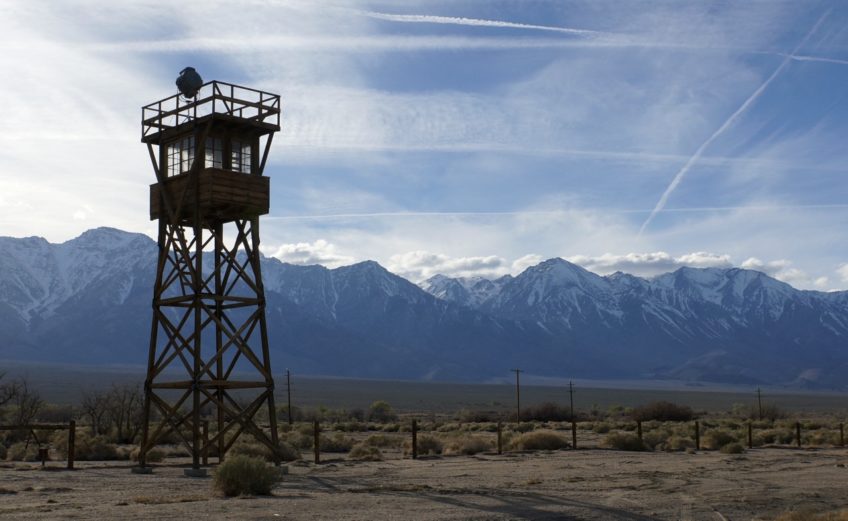After three full days of exploring, I figure that my mom and I had only put a dent in the list of potential adventures that make Death Valley so spectacular. I’ll just have to add it to my list of parks to return to, especially if I can find someone with a Jeep to tag along… Our departure from the park, however, was undeniably beautiful. The Sierra Nevada Mountains spread before us like the crenelated walls of an alpine castle. Dropping into the Owens Valley, we made the decision to wander north before setting our sights on Los Angeles.

With the Sierras flanking us to the west, we motored north. A few minutes later, we found ourselves in the surprisingly charming town of Lone Pine. Archaic neon signs flashed above fast food restaurants, an old movie theatre posted times for classic films, and the hotels that dotted the strip felt like they belonged on Route 66. It felt like an homage to the golden years of American road trips. All of the sudden, a different sign caught my eye. It was a gear shop! I never pass up an opportunity to peruse a locally owned and operated outdoor store. For starters, they generally are full of people who might care about what I am doing or might be able to offer tips for what I should do while I am in the area. Then, of course, there is the potential for deep discounts. At this point, the list of things that I need is very small, but I am endlessly looking for those items at lower-than-usual price points. Elevation turned out to be a very well curated collection of climbing, backpacking, and active lifestyle gear. The patio overflowed with sale items and the bearded purveyor had a soft spot for Wisconsinites. It was my kind of place! My mom and I spent the next forty-five minutes chatting and hunting through the shelves for necessities. In the end, my mom scored big, while I continued to hold out for the perfect pieces of gear that continued to elude me.

Content with our tour of Lone Pine, we continued north towards Manzanar. For close students of WWII history, this name may ring a bell. Three months after the Japanese attack on Pearl Harbor in 1941, Franklin D. Roosevelt signed Executive Order 9066. In effect, 9066 authorized the American military to declare the western coast of the United States as a military zone and relocate all potential Japanese sympathizers to camps within the zone. Manzanar became the first of ten internment camps built to house the 110,000 Japanese-Americans that would be interred for the duration of WWII. Of the 110,000 interned in these camps, most were full citizens of the United States of America.



By March of 1942, American military forces removed thousands of Japanese-Americans from their homes and brought them to camps like Manzanar. Allowed to only bring a suitcase or two, these internees left behind their former lives. Businesses shuttered their windows and locked their doors, hoping that they would be able to return eventually. Farm owners had to sell their land quickly or turn it over to the government for safekeeping. Homeowners vanished, leaving lifeless shelters in their wake. At Manzanar, these men, women, and children would find thirty-six tarpaper buildings measuring twenty foot by one hundred foot. Those buildings would house the ten thousand internees who had been relocated to Manzanar. They would live there for the next three years.



Now, Manzanar is a barren wasteland, as if the relics of its controversial history had been purposefully erased. Desert shrubs and low trees have reclaimed the plots where the barrack-like, tarpaper buildings would have stood. Tumbleweeds aimlessly wander the landscape in the gusting valley winds. At first glance, there is nothing hospitable about it. As we walked down old roads, crossed dirt basketball courts, and gazed past gnarled trees at the harsh mountains in the distance, we began to notice a network of gardens and water features dotting the otherwise overgrown skeleton of Manzanar. In an effort to beautify their newfound home and to bring nature inside the confines of their barbed wire prison, the internees at Manzanar relocated boulders, diverted water sources, and planted extensively to create oases of calm, natural beauty. Despite their oppressive and unconstitutional treatment at the hands of the US government, the Japanese-Americans imprisoned at Manzanar beautified an otherwise hopeless environment. For me, each garden represented the enduring spirit of every man, woman, and child at Manzanar.




At the back of the compound, an engraved stone pillar marks the camp’s cemetery. Almost 150 incarcerees died at Manzanar. Causes of death ranged from suicide to old age, from murder to exposure. Now, only five graves remain. Adorned with thousands of folded paper cranes and family mementos, the graves serve as yet another reminder of the suffering that took place at Manzanar. The barbed wire that encircles the cemetery robs this sanctuary of its serenity, forcing all who visit to come to terms with the unethical treatment of over tens of thousands of American citizens during WWII.



To this day, anyone coming or going from Manzanar must pass directly under the watchful gaze of a lone watchtower. Originally, eight towers filled with armed military policemen monitored the barbed wire perimeter of Manzanar. Today, only one vacant tower remains. Staring up at the guard tower before we left, I couldn’t help but take a moment to analyze my reaction to this haunting place. I had found the entire visit overwhelmingly poignant. Although I have never visited one of the Nazi concentration camps in Europe, I imagine that that visit will strike a similar cord. My regret for what happened at Manzanar, however, feels all the more real because the pain inflicted flowed through the same legal process and government that we are taught to revere and uphold. I also felt a tinge of fear. Considering some of the political rhetoric that has been thrown around during this election season, I find it hard to believe that we have outgrown our xenophobic history. There is a very real future where something like Manzanar happens again. Let’s hope it doesn’t come to that.




One Response
Jean Cronon
I was especially moved by the heartbreaking story about Manzanar because Henry and Miye Kanazawa who live at Oakwood and moved in the same year I did. I got to know them very well. They told me about this place. He became a very famous architect and died about a year ago.